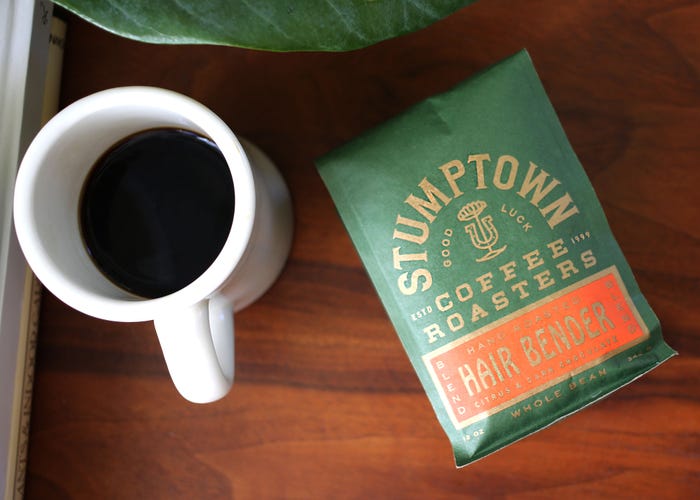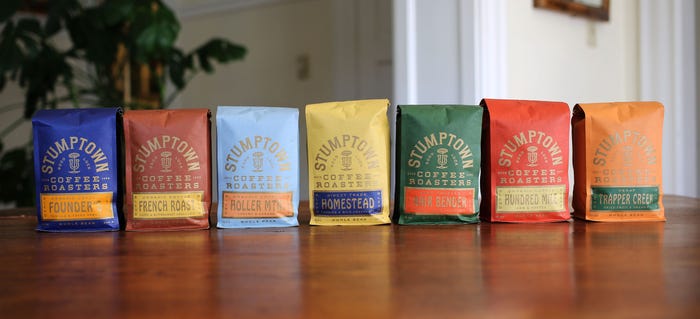Specialty Coffee Roaster Stumptown Supports Sustainable Bags
For coffee companies, the coffee bag has a critical part to play in the transition from farm to consumer.

Specialty coffee roaster Stumptown recently partnered with Woodinville, Wash.-based Pacific Bag Inc. (PBi), makers of Biotrē bags. “We wanted to move our coffee into a more environmentally friendly package that helps the coffee stay fresher, longer,” says Stumptown’s Mallory Pilcher. Headquartered in Portland, Ore., the company began roasting coffee in 1999.
For coffee companies, the coffee bag has a critical part to play in the transition from farm to consumer. From the aesthetic look and feel of the bag to its ability to maintain the freshness of the coffee beans or coffee grounds, the composition and format of the bag both matter.
A laminated coffee bag may consist of 48-gauge polyester, foil and low-density polyethylene (LDPE). What makes creating an environmentally friendly coffee bag difficult are the parts that maintain coffee freshness, from closures to the valves that are used to allow gas to escape without oxygen getting in. These valves are usually made from plastic.
Biotrē 1.0 bags, which Stumptown uses, consist of 60 percent wood pulp-based material that breaks down within 90 days. The remaining 40 percent is polyethylene with an additive that is designed to make it break down over five to ten years. “It’s an accelerated process instead of being stuck in the ground for 100 years and never going anywhere,” says Ying Li, director of key accounts for PBi.

The bags are heat-sealed and have a one-way degassing valve, which supports Stumptown’s focus on freshness. “Coffee can be preserved for much longer with smaller quantities of oxygen impacting the beans,” says Pilcher. “Our number one intent was to elevate the quality of our coffee by packaging it in a better bag.”
Biotrē 1.0 bags differ from other bags labeled compostable because they at least offer a decent barrier of protection from moisture and oxygen, says Ying Li. When PBi launched Biotrē in 2011, it invited coffee roasters to test the product by doing “cupping” tests, which means roasting, brewing and tasting coffee and rating its qualities. PBi would cup the beans about every two weeks for about three months, rating the freshness of the beans and charting any changes, such as in taste, smell or flavor. PBi has several specialty roaster clients using its 1.0 bags, as well as its 2.0 bags that were released about a year ago.
PBi sees the bags as part of a trajectory toward finding a fully compostable solution. When launching the product, PBi asked clients to be part of its movement, knowing that making the bags sustainable could also make them more expensive.
“These things always tend to cost a little bit more, either because of the technology to make the product compostable or biodegradable, or just because you are making them on a smaller scale,” says PBi Executive Vice President Bill Walters. “We said to our customers—it wasn’t the leading line in our marketing literature, but I know that our sales people were saying it—‘Join us in the cause.’ Would you join with us in getting to step one, even though it’s not the ultimate, complete solution?”

With 1.0 as step one, and 2.0 as the evolution, PBi has already got 3.0 under development. Biotrē 1.0 is 60 percent compostable and 60 percent renewable, not including the valve. Biotrē 2.0 is 60 percent compostable and 100 percent renewable, including the valve. Biotrē 3.0, which is currently under development, will be 100 percent compostable and 100 percent renewable, including the valve.
For Stumptown, the package is just as important as what is inside because it all represents the company’s brand and values. “Stumptown is focused on sourcing, roasting and serving the highest quality coffee you can find. We use our brand voice, intention and experience to get that quality coffee into as many hands as possible. Our hope is that by putting thoughtful, creative energy into all aspects of how [customers] interact with our brand, [their] interaction is of a higher quality,” says Pilcher.
About the Author
You May Also Like


